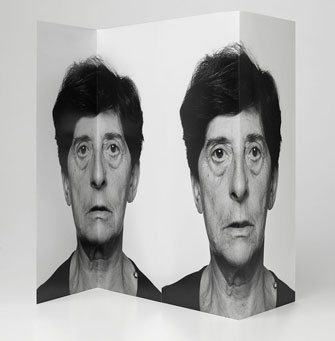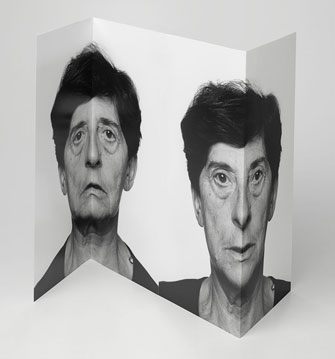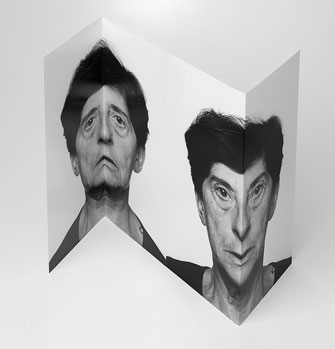An Artist’s Unsparing
Self-Portrait/Shrine to Herself

“Tête Pliée” (2002), from the series “Le Livre des Têtes,” by Esther Ferrer.
“Face B. Image/Autoportrait” is an interesting and funny exhibition of edited photographs, videos and sculptures by Spanish artist Esther Ferrer at MAC/VAL (Musée d’Art Contempor-
ain du Val-de-Marne).
The exhibition is about identity; it’s a “self-portrait.” We are, in part, what we do. Ferrer is identified with the forms she’s made, which are identified with the content, which is identified with a constructed subject. This subject is vain, divided, compulsive, frightened, playful, ironic and ironized, infinitely regressive.
The subject is vain primarily because she meticulously (and insightfully) criticizes herself. There’s vanity in meticulous self-criticism: she draws herself, studies herself, films herself, builds sculptures about herself, photographs herself and edits pictures of herself. She builds a mirror with which she can try on all the various pairs of glasses (lenses, ways of seeing the world) that she has accumulated over the years; the glasses are attached to the mirror by long chains (“Regarde-moi ou Regarde-toi avec d’Autres Yeux,” 1987). She covers four walls of a huge space with objects whose only common feature is their close relation to herself. She makes a kind of ridiculous shrine to herself.
Divided because of the number and degree of differences between the various depictions. We move from one of Ferrer burning some substance in a bowl to one of her wearing a blue cabbage as a hat (“Les Choses,” version 2011) to one of her performing a set of silly facial expressions. She’s not identical with any one lens attached to the mirror; she’s just the structure that (temporarily) holds them all together. She’s framed in multiple ways, perhaps by others. One image of her hangs from a string noose. Another is made into the jewel of a necklace.
Compulsive because of the way she cuts up and reassembles images of herself from different

“Tête Pliée” (2002), from the series “Le Livre des Têtes,” by Esther Ferrer.
points in time (ranging from 1981 to 2014) and meticulously individuates and measures different parts of her body with a tape measure (“Actions Corporelles,” 2013). In the face of time’s chaotic impositions, the compulsion is for order and control, a compulsion at once urgently expressed and mocked.
Frightened, first because the artist is dying an exposed death, obsessively foreshadowed by a set of photographs of her aging body and by two videos of her performing similar tasks with a 38-year interlude in between. But Ferrer also seems frightened of being consumed by various external objects as though they were illnesses. In one photograph, she has wild eyes and a credit card for a tongue (“Autoportrait,” 2013); in another, she vomits up an alphabet (“Sans Titre,” 2011). Fear seems to grow from the realization that she’s the servant – not the master – of money and language.
Playful because she produces silly images for fun. A plunger stuck on her head. Multicolored cabbage hats, which somehow possess their own pair of the subject’s eyes. A hilarious, grotesque snout made of duplications of her own face (“Métamorphose [ou L’Evolution],” 2005). Multicolored pubic hair – the label calls it the source of all good and evil, as if the distinction is derided, transcended and then replaced by humor.
Yet Ferrer is the self-conscious subject of her work. For every thought, there is another that stands in a relation of ironic detachment to it. In a sequence of self-portraits called “Auto-

“Tête Pliée” (2002), from the series “Le Livre des Têtes,” by Esther Ferrer.
portrait Aléatoire,” for example, each one is a commentary on and distortion of the last. This impression also arises from her edited photographs, which often feature hands manhandling the original subject; the ironic subject abuses the ironized, before being in turn abused by another ironic subject in an endless chain.
MAC/VAL: Place de la Libération, 94404 Vitry-sur-Seine. Métro: Porte de Choisy, then bus 183 (get off at the Moulin de Saquet-Pelletan stop). Tel.: 01 43 91 64 20. Open Tuesday-Friday, 10am-6pm; saturday-Sunday and public holidays: noon-7pm. Admission: €5. Through July 13. www.macval.fr
Reader reaction: Click here to respond to this article (your response may be published on this page and is subject to editing).
Please support Paris Update by ordering books from Paris Update’s Amazon store at no extra cost. Click on your preferred Amazon location: U.K., France, U.S.
More reviews of Paris art shows.
© 2014 Paris Update
Favorite